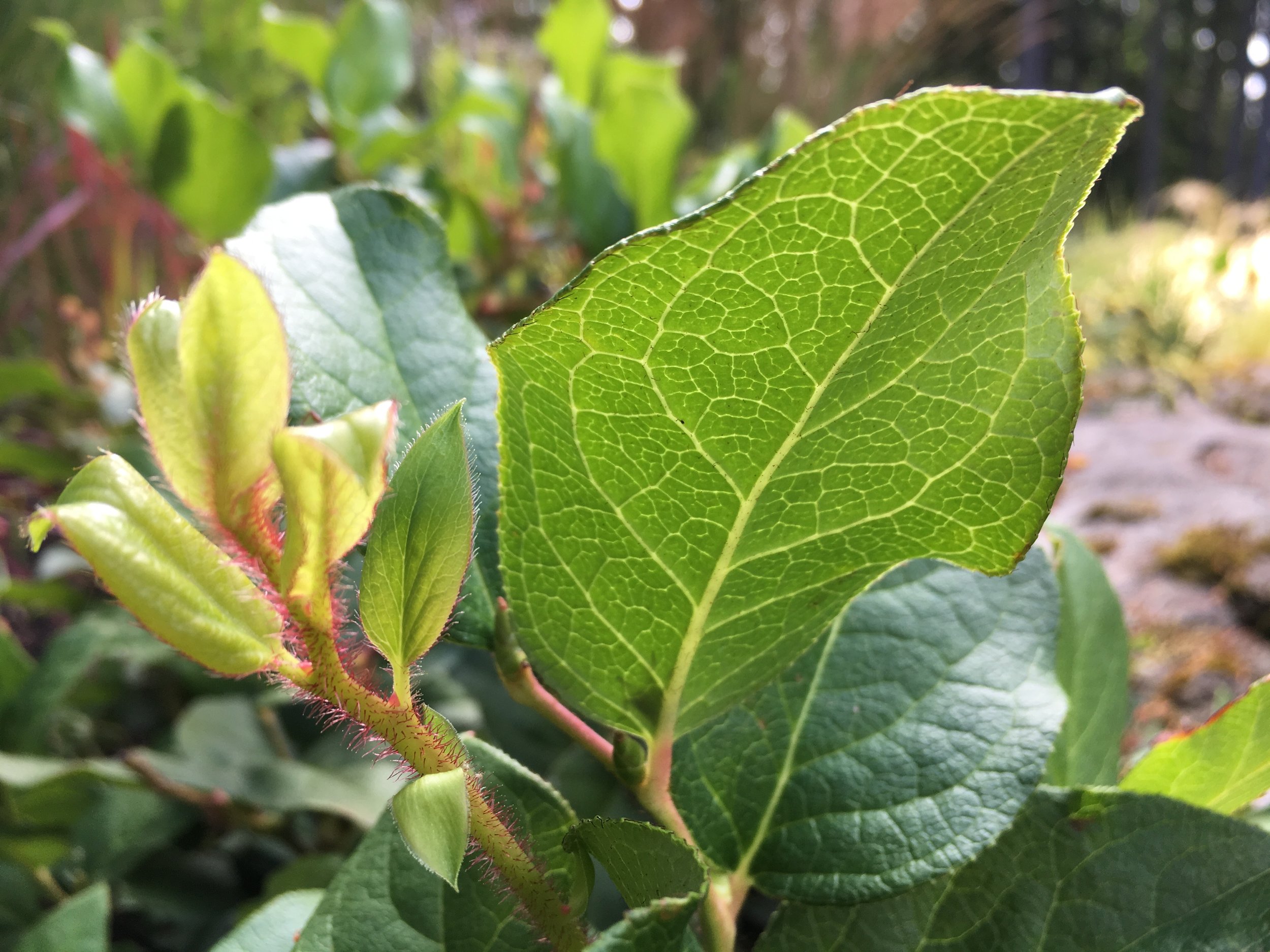Flowers
Berries
Leaf underside
Recipe for Salal Oregon-grape Jelly
Pick ripe berries of salal and Oregon-grape (Mahonia aquifolium), cook separately and strain to make juice
2 cups salal berry juice
2 cups Oregon-grape juice
4 cups of sugar
1 box of powdered pectin
Follow recipe on pectin box for blueberry jelly. (You can also experiment with the new low-sugar/no-sugar fruit spreads.) Store in a cool place. Use on toast, crackers, pancakes or ice-cream.
Plant of the Month - July
Salal (Gaultheria shallon)
Salal is a broad-leaved evergreen shrub, well known to almost everyone living on the Northwest Coast of Canada and the United States. It grows in dense patches as an understorey in our coastal forests, including at Wildwood. It’s bright-green, oval, leathery leaves, pointed and finely toothed around the margins, are so attractive and so enduring that the leafy branches are harvested for floral decorations, to be found in bouquets sold all around the world. But for First Nations and other local people of British Columbia’s coast, salal has much more to offer: Its dark purple, juicy berries are prized as a food, its leaves can be used as a flavouring in cooking, and can also be used medicinally as a poultice for cuts and wounds.
A member of the heather family (Ericaceae), salal is related to arbutus, rhododendron, blueberries, kinnikinnick and manzanita, among other species of our region. In the rainy Coastal Western Hemlock zone of the West Coast, salal can grow up to 3 m tall, often forming impenetrable thickets. At Wildwood, within the drier Coastal Douglas-fir zone, it tends to grow around 1 m high. Its flowers, which bloom in early summer, are small, pinkish white and urn-shaped, borne in a row of 5-15 or more hanging along the underside of the flower stalk. At the base of each flower, where it joins its short stalk, there are glands bearing sweet nectar. If you bite this part of the flower, you can taste the nectar, but remember that it also sustains bees and other pollinating insects, and later, the pollinated flower will ripen into a dark purplish, slightly hairy and glandular berry that has a star-shaped depression at its end. When the berries are ripe, in mid- to late summer, they can be picked quickly by removing the entire stalk of berries at once. At the end of the day, the individual berries can be separated from the stalks, to be eaten fresh, frozen or cooked in various ways.
For First Nations of the Northwest Coast, salalberries are one of the most highly valued fruits. They were – and still are – harvested in quantity, especially for winter use. In the past, the main method of processing the berries for storage was to cook them in wooden boxes or baskets, using red-hot rocks dropped into the mashed berries. Once cooked to a jam-like consistency, the berries were poured out onto a flat surface – preferably on a matting of skunk-cabbage (Lysichiton americanus), because these are so large and have a waxy coating that prevents the berries from sticking to the surface [but DO NOT eat the skunk-cabbage leaves!). These leaves holding the berry mix were set onto a drying rack. When dried on one side, the salal berry “leather” could simply be peeled off, turned over to dry on the other side and then stored away. In winter, the dried berries were simply rehydrated by soaking in water overnight before being eaten. Salal berry cakes were also an important item of trade.
More recently, salal berries have been jarred, frozen or made into jam or jelly. They can also be used in muffins, pies, pancake topping, and as a flavouring for ice-cream. Because they are sweet, they can be mixed with other, more tart fruit, such as Oregon-grape berries, to balance the flavours. A recent study (Fergusonet al. 2018) showed that salal berriescontain a diversity of health-promoting phenolics, including proanthocyanidin and anthocyanin, which have antioxidant qualities. In these compounds, they exceed blueberries, pomegranate and other fruits widely promoted for their antioxidants.
Salal leaves can be used like bay leaves to flavour soups and stews. In traditional cooking pits, or earth ovens, used to cook clams, camas, and other foods, armloads of wet salal branches were placed over the red-hot rocks at the bottom of the pit, to protect the food to be cooked and also to flavour it during the cooking process. Another use of salal, by children, is to make decorative headbands from the leaves, overlapped and pinned with thin, sharp twigs.
Salal is named in every one of the 30 or so Northwest Coast Indigenous languages. The local Hul’q’umi’num’ (Quw’utsun’) name for the berries ist’eqe(or t’eqe’), an ancient word for berry that goes back to the ancestral language of all the Salishan languages, called Proto-Salish. In some languages, there is a word for the leafy branches of salal, distinct from that for the berries. For example in the Kwak’wala language, the name for the berries is n’ekw’elh, whereasthe name for the leafy branches without berries islhenem.The Kwakwaka’wakw have the word t’eqqa(borrowed from the Salishan name for salalberries) in their language, but in Kwak’wala, it refers to any kind of dried berry.
References
Ferguson, A., E. Carvahlo, G. Gourlay, V. Walker, S. Martens, J-P Salminen, and C. P. Constabel. 2018. Phytochemical analysis of salal berry (Gaultheria shallonPursh.), a traditionally-consumed fruit from western North America with exceptionally high proanthocyanidin content/ Phytochemistry147: 203-210. URL: https://doi.org/10.1016/j.phytochem.2018.01.002.
Klinkenberg, Brian. (ed.). 2017. E-Flora BC: Electronic Atlas of the Plants of British Columbia. Eflora.bc.ca Lab for Advanced Spatial Analysis, Department of Geography, University of British Columbia, Vancouver. URL: http://linnet.geog.ubc.ca/Atlas/Atlas.aspx?sciname=Gaultheria%20shallon[accessed: 12/11/2018 10:30:44 AM]
Kuhnlein, Harriet V. and Nancy J. Turner. 1991 (URL version Published online March 2009). Traditional Plant Foods of Canadian Indigenous Peoples. Nutrition, Botany and Use. Volume 8. In: Food and Nutrition in History and Anthropology, edited by S. Katz. Philadelphia, PA: Gordon and Breach Science Publishers; URL: http://www.fao.org/wairdocs/other/ai215e/ai215e00.HTM(UN Food and Agriculture Organization, FAO, Rome)
Ricou, Laurie. 2007. SALAL Listening for the Northwest Understory. Edmonton, AB: Newest Press,
Turner, Nancy J. 2010. Food Plants of Coastal First Peoples. Victoria: Royal BC Museum.
Turner, Nancy J. 2014. Ancient Pathways, Ancestral Knowledge: Ethnobotany and Ecological Wisdom of Indigenous Peoples of Northwestern North America. Montreal, QC: McGill-Queen’s University Press.
Turner, Nancy J., John Thomas, Barry F. Carlson and Robert T. Ogilvie. (1983). Ethnobotany of the Nitinaht Indians of Vancouver Island. Victoria: British Columbia Provincial Museum Occasional Paper No. 24.
Turner, Nancy J. and Richard Hebda. 2012. Saanich Ethnobotany: Culturally Important Plants of the WSÁNEC’ People.Victoria: Royal BC Museum.





